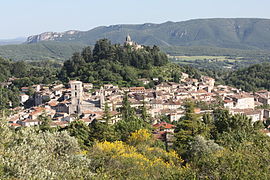Forcalquier
Forcalquier
Subprefecture and commune in Provence-Alpes-Côte d'Azur, France
Forcalquier (French pronunciation: [fɔʁ.kal.kje]; Occitan: Forcauquier, pronounced [fuɾkɔwˈkje]) is a commune in the Alpes-de-Haute-Provence department in southeastern France.
You can help expand this article with text translated from the corresponding article in French. (December 2008) Click [show] for important translation instructions.
|
Forcalquier is located between the Lure and Luberon mountain ranges, about 30 km (19 mi) south of Sisteron and 10 km (6.2 mi) west of the Durance river. During the Middle Ages it was the capital of Haute-Provence.




